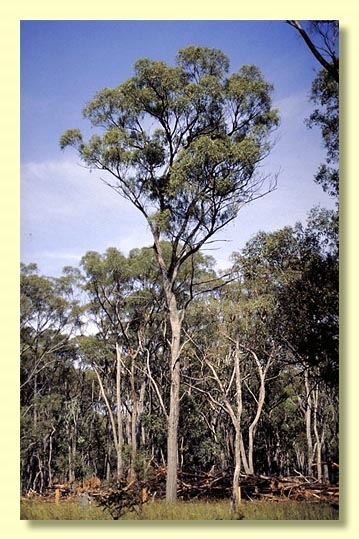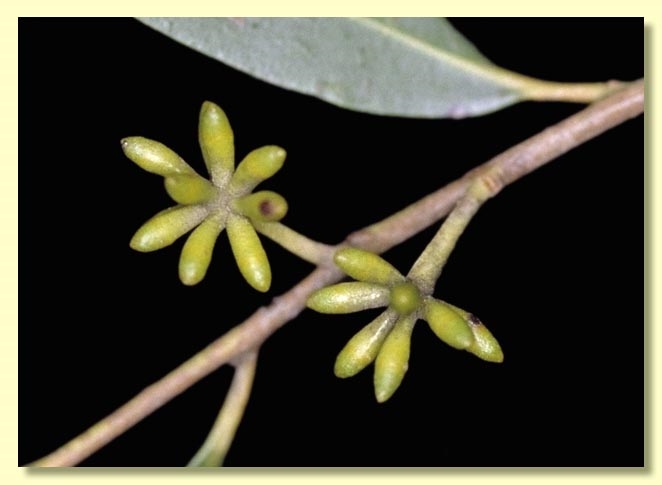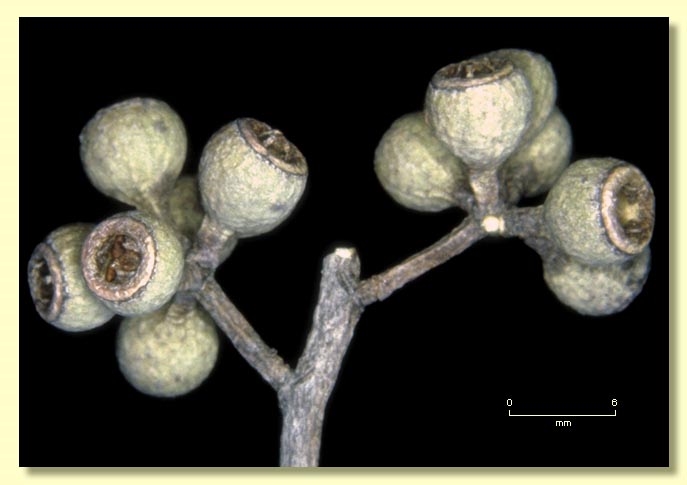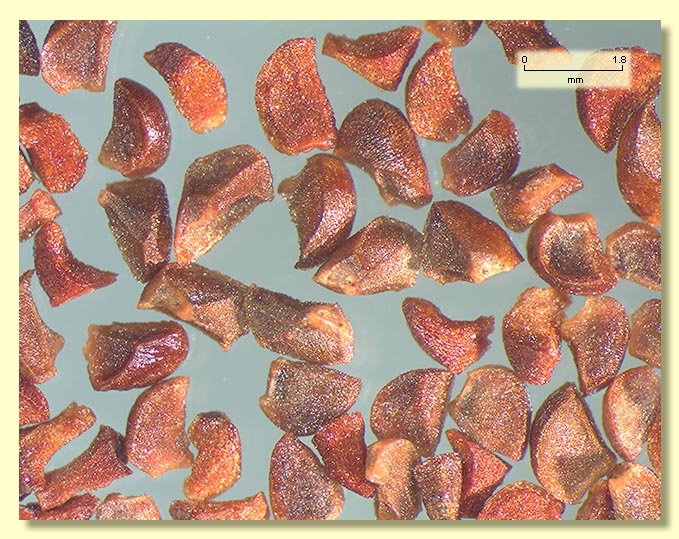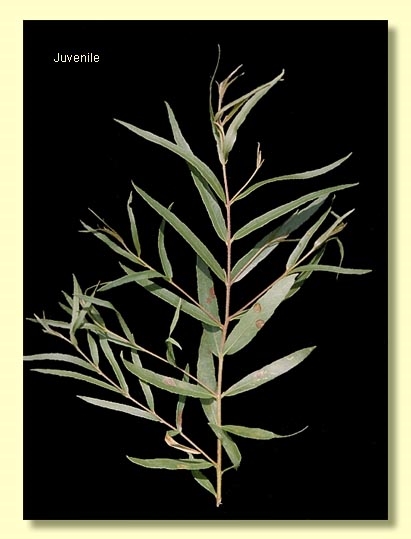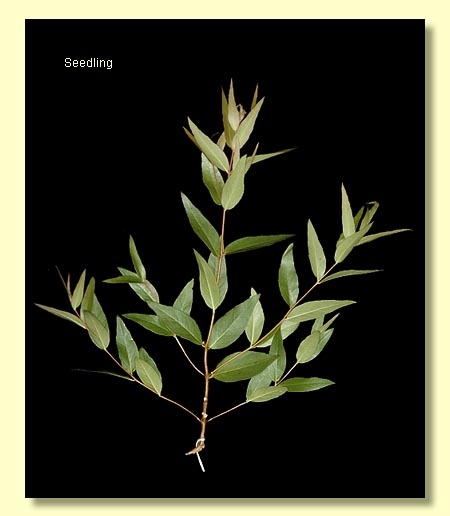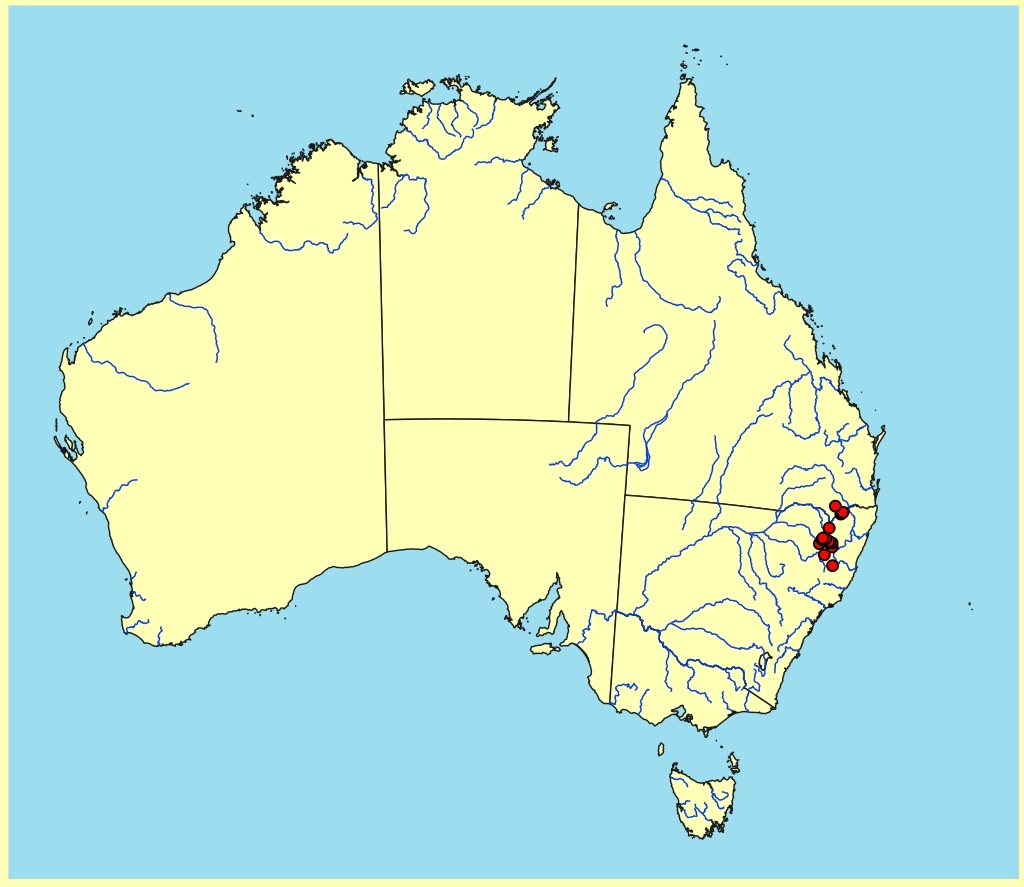Euclid - Online edition
Eucalyptus mckieana
Eucalyptus | Eucalyptus | Capillulus | Pachyphloius
Bark rough to small branches, stringy, deeply fissured, grey or grey-brown.
Juvenile growth (coppice or field seedlings to 50 cm): stem rounded in cross-section, scabrid; juvenile leaves always very shortly petiolate, opposite for 8 to 10 nodes then becoming sub-opposite to alternate, earliest leaves ovate but soon linera to narrowly lanceolate, 3–7 cm long, 0.2–1.3 cm wide length: width ratio range ca 8 to 15), margin entire or irregular, base rounded, apex pointed, discolorous, glossy, green; scabrid on stems, petioles, leaf margin and midrib on underside for a few nodes. Leaf margin "lenticels" present.
Adult leaves alternate, petiole 0.5–1.3 cm long; blade lanceolate to falcate, 6–11.5 cm long, 1–2.2 cm wide, base usually oblique, apex pointed, margin entire or minutely and distantly denticulate due to "lenticels", concolorous, glossy, green, side-veins usually acute, reticulation absent to sparse, intramarginal vein parallel to and remote from margin, oil glands island.
Inflorescence axillary unbranched, peduncles 0.5–1 cm long, buds in umbels of 11 or ?more, pedicels 0.2–0.4 cm long. Mature buds ovoid to fusiform, 0.5–0.6 cm long, 0.3 cm wide, smooth, scar absent, operculum conical, stamens irregularly flexed, anthers reniform to cordate, versatile, dorsifixed, dehiscing by confluent slits, style long, stigma tapered, locules 3 or 4, the placentae each with 2 vertical ovule rows. Flowers white.
Fruit sessile or with pedicels to 0.3 cm, cup-shaped, shortly barrel-shaped or hemispherical, 0.4–0.6 cm long, 0.5–0.7 cm wide, disc raised and convex to annular, or level, valves 3 or 4, near rim level or slightly exserted.
Seeds brown, 1–1.5 mm long, pyramidal or obliquely pyramidal, dorsal surface smooth, hilum terminal.
Cultivated seedlings (measured at ca node 10): cotyledons reniform; stems rounded in cross-section, stellate-hairy; leaves very shortly petiolate, opposite until node 8 to 10 then alternate, ovate to broadly lanceolate, 3–8 cm long, 0.6–2.5 cm wide, base rounded, margin entire, apex pointed, slightly discolorous, darker green and glossy above, paler beneath. Stems and leaves scabrid with stellate hairs to at least node 11, but leaves only ever hairy on margins, petiole and midrib underneath.
Flowering has been recorded in April and July.
A small to medium-sized stringybark tree from New South Wales and immediately adjacent parts of Queensland, occurring on poor granitic and porphyry acid soils of the western side of the Northern Tablelands and adjacent North-western Slopes, particularly from Bendemeer and Armidale to Inverell, and in Queensland only in the area south of Stanthorpe. Eucalyptus mckieana is fully rough-barked with a glossy green crown, small, shortly pedicellate ovoid buds, and truncate-globose fruit 0.5–0.7 cm wide with usually a flattish or convex disc. Juvenile leaves are linear to narrowly lanceolate, glossy green and discolorous but only sparsely scabrid.
In its area of occurrence, E. mckieana is distinguished from all other stringybark species by the narrow juvenile leaves. It is probably most closely related to E. tenella (a NSW endemic occurring further south) that has more or less sessile buds and fruit, with often longer adult leaves and more hairy/scabrid juvenile leaves. Both species can have adult leaves with "lenticels" on the margin. E. tenella occurs further south in the Rylstone area, Megalong Valley and inland from Nowra.
Eucalyptus mckieana is listed as "Vulnerable" under the Australian Government Environment Protection and Biodiversity Conservation Act 1999 (EPBC Act). Further information may be found at this web address:
http://www.environment.gov.au/cgi-bin/sprat/public/sprat.pl
MORE ABOUT STRINGYBARKS

